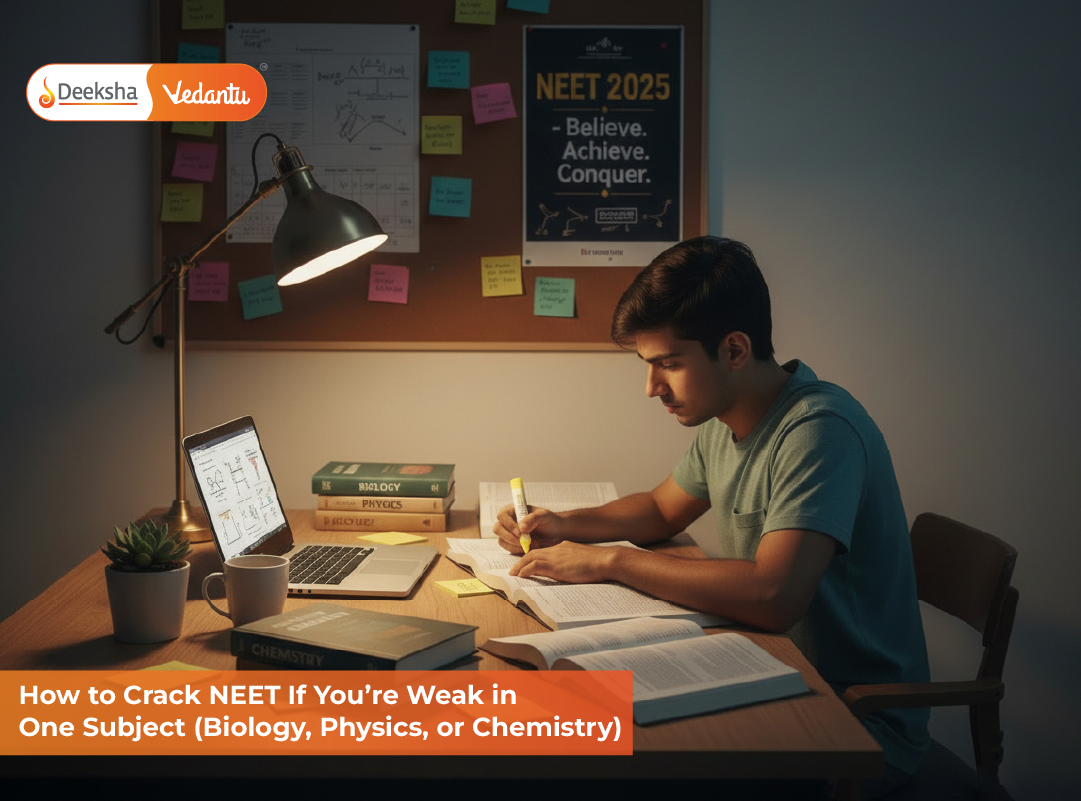Modern Physics is one of the highest ROI chapters in NEET Physics. With 2–3 direct questions almost every year, it is considered one of the most scoring areas, especially for students who are clear with formulas and fundamental concepts.
The core topics under Modern Physics include:
- Photoelectric Effect
- Dual Nature of Matter and Radiation
- Einstein’s Equation
- de Broglie’s Hypothesis
- Basic numericals involving stopping potential, work function, and particle wavelength
These topics are directly picked from NCERT and require minimum memorization beyond the standard formulas.
In this blog, you’ll find:
- Key concepts and explanations
- Must-know formulas
- Previous year NEET questions
- Practice questions with detailed solutions
Explore Deeksha Vedantu Long Term NEET Coaching to boost your NEET Scores today.
Modern Physics in NEET: Chapter Weightage & Trends
Explore Deeksha Vedantu Long Term NEET Coaching to boost your NEET Scores today.
Weightage:
Modern Physics consistently contributes 2–3 questions every year, which equals around 8–12 marks—with minimal calculation and maximum conceptual recall.
NEET Trends (2020–2024):
| Year | Questions Asked | Topics Covered |
| 2020 | 3 | Photoelectric effect, Stopping potential |
| 2021 | 2 | de Broglie wavelength, Photon energy |
| 2022 | 2 | Threshold frequency, Work function |
| 2023 | 3 | K.E. of electrons, Planck’s constant |
| 2024 | 2 | Dual nature MCQ, Equation-based question |
NEET Style:
- Mostly NCERT-based theory or direct formula applications
- Requires strong grip on units, constants, and dimensional accuracy
- Commonly tested with one-liner fact-based questions or short numerical setups
Photoelectric Effect: Concept & Equations
What Is the Photoelectric Effect?
The photoelectric effect refers to the emission of electrons from a metal surface when it is exposed to light of a certain frequency or higher.
- Heinrich Hertz first observed this phenomenon.
- It was later explained by Albert Einstein, who introduced the idea of photons (packets of energy).
- This confirmed that light has particle-like behavior, especially at high frequencies.
Einstein’s Photoelectric Equation
Where:
= Planck’s constant
= Frequency of incident light
= Work function of the metal
= Kinetic energy of emitted electron
This equation explains how a photon transfers its energy:
- A portion goes into removing the electron (work function)
- The rest becomes the kinetic energy of the ejected electron
NEET Applications:
- Calculating threshold frequency (f₀):
- Finding stopping potential (V₀) using:
- Determining maximum K.E. of emitted electrons
- Conceptual questions on intensity vs energy of light
Learn more with NEET Mock Test
Dual Nature of Matter & Radiation
de Broglie Wavelength Formula
According to Louis de Broglie, matter like electrons and protons also behave like waves, especially at atomic scales.
Where:
= de Broglie wavelength
= Planck’s constant
= mass of the particle
= velocity of the particle
= momentum
This dual behavior explains:
- Electron diffraction
- Wave-like interference of particles
- Why particles behave like waves at the quantum level
NEET Applications:
- Questions involving moving electrons, protons, or neutrons
- Comparing wavelength with mass or velocity
- Conceptual MCQs: “Which has a shorter de Broglie wavelength?”
Key Formulas to Remember
Here’s a quick reference table of all the key formulas from Modern Physics that are frequently used in NEET:
| Concept | Formula |
| Photoelectric Equation | |
| Energy of Photon | |
| de Broglie Wavelength | |
| Stopping Potential | |
| Work Function / Threshold freq |
Tip: NEET MCQs often present values in eV, nm, or Joules—so make sure to remember:
Previous Year NEET Questions: Modern Physics
These are actual NEET-style questions from recent papers, showcasing common patterns and direct formula applications.
Q1. NEET 2024:
A photon of energy 6 eV is incident on a metal surface with a work function of 2 eV. What is the kinetic energy of the emitted electron?
Answer:
Q2. NEET 2023:
What is the de Broglie wavelength of a particle with mass kg and velocity
m/s?
(Use )
Answer:
Q3. NEET 2022:
The threshold frequency for a metal is . What is the work function? (Use
)
Answer:
In eV:
Q4. NEET 2021:
Which of the following quantities has the same dimensions as Planck’s constant hhh?
A) Energy
B) Momentum
C) Angular momentum
D) Force
Answer:
Planck’s constant has units of angular momentum.
Correct option: C
Practice Questions: Modern Physics
Q1. Light of wavelength 400 nm falls on a metal with work function 2.2 eV. Find the stopping potential.
Solution:
In eV:
Q2. Which photon has more energy: UV light with 200 nm wavelength or IR light with 800 nm?
Solution:
,Shorter
,
So, UV photons have more energy than IR.
Answer: UV light.
Q3. If the kinetic energy of an electron is doubled, what happens to its de Broglie wavelength?
Solution:
So the wavelength decreases by a factor of 2sqrt{2}2
Q4. What is the momentum of a photon of wavelength 500 nm?
Solution:
Q5. A metal has a threshold wavelength of 600 nm. Will light of 450 nm cause photoemission?
Solution:
Yes. Since 450 nm < 600 nm, it has higher energy than threshold.
Answer: Yes, photoemission will occur.
FAQs on Modern Physics for NEET
Is Modern Physics difficult for NEET?
Not at all. It’s one of the easiest and most scoring chapters. All you need is clarity on concepts and formulas like Einstein’s equation and de Broglie wavelength.
Are there derivations in NEET from this chapter?
No. NEET never asks for derivations. It tests your understanding of concepts and ability to apply standard formulas to simple situations.
How many questions come from Modern Physics?
Usually 2–3 questions every year—making this a high-weightage, low-effort chapter to prepare.
Which books are best to prepare for this chapter?
- NCERT Physics (Class 12 Part 2) – Must read
- MTG 33 Years NEET PYQs
- DC Pandey (Objective Physics) – for practice questions
Check out our NEET Residential Coaching option for focused preparation.
Conclusion
Modern Physics is a formula-first and concept-driven chapter that rewards smart preparation. With just 4–5 formulas and basic logic, you can confidently solve all NEET questions from this unit.
To master this chapter:
- Understand the concept behind photoelectric effect and dual nature
- Memorize key formulas and unit conversions
- Solve 50+ practice MCQs and analyze PYQs for patterns
Table of Contents










Get Social